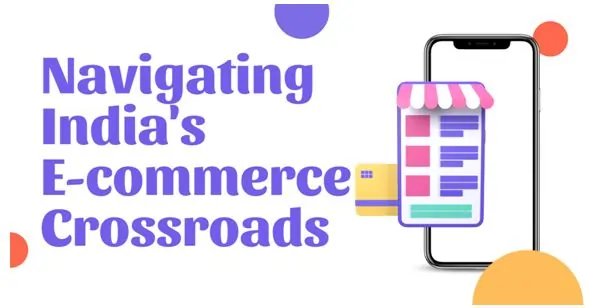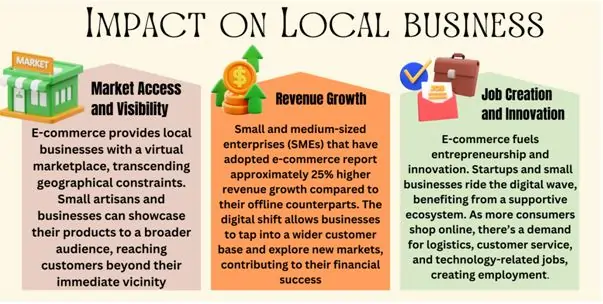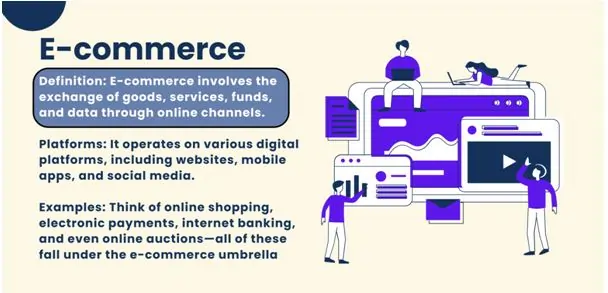
The Growth Story:
- Over the last one and a half decades, e-commerce has evolved from the sphere in its infancy into the abundant $62 billion market (in 2023).
- E-commerce has been on the government’s strategic focus area for investment as it has classified it as a sunrise sector and has been able to attract good FDI.
Empowering Consumers:
- The conventional consumer protection laws in India were weak and even if there were some consumer protection laws they were rarely implemented in practice. There was little that consumers could do when it came to lack of variety and when they were served with low quality service or bad products.
- E-commerce platforms have revolutionized the consumer experience:
- Large number of products, quick delivery and easy return services.
- To promote buyers-use network information support, online reviews help buyers to gain benefits from collective wisdom.
- Remarkably, it does not only enfranchise the upwardly mobile, liquid-yet-limited urban elites; rural, lower income consumers can now access products and brands that were beyond their reach before.
Balancing Gains and Losses:
- Yes, certainly e-commerce has eliminated few small stores andhad its negative impact on employment in certain fields (electronics and lifestyle).
- Nevertheless, it cannot be denied these losses should be balanced if one is to consider the strengths it brings to consumers and to the economy as a whole.
- The availability, variety and relatively affordable prices which come along with e-commerce have made lives of millions of Indians better.
Fair Play and Regulation:
- It is for this reason that the Policy makers have also expressed sentiments to the effect that there is huge social disruption from e-commerce.
- It is, therefore, a fair play where these online and the offline stores exist side by side and in some balance.
- It is therefore recommended that regulations that are aimed at the sharing economy should aim at levelling the playing ground as opposed to acting as barriers to innovation.
Therefore, it can be stated that e-commerce has positively impacted the world; nevertheless, the negative externalities that it entails must be resolved. The current state of e-commerce in India stands at a crucial juncture and it is imperative that the policymakers create a positive environment for the four parties involved which include the consumers, the retailers, the online marketplaces as well as the economy as a whole.
Issues affecting e commerce in Indian
Significant development has been observed in the structure and functioning of the e-commerce industry of India still it does come across a number of issues. Now let’s explore some of the key hurdles faced by e-commerce businesses in the Indian context:
Lack of Proper Knowledge and Market Research:
- Bear in mind that a lot of the clients starting selling their products online lack preparation. Lack of adequate information on the market forces and consumer behaviour and changes in the market force can prove very costly.
- It also means that learning is continuous and market research has to be carried out to the best of the abilities. Fortunately, there are many quality seller training materials offered inside different markets to make seller aware.

Choosing the Right Product:
- One of the biggest difficulties of the whole process is the search for a popular and niche product. This makes the task hard given the cut-throat competition that now exists across all product segments as well as looming slim product margins.
- Sellers need dedicate considerable amount of time discussing and searching for profitable products to offer on their sites.
Profitability Concerns:
- Many sellers in the marketplace experience charges such as commissions which range averagely 40% of the selling price. Other expenses include cost of packaging; cataloging, handling and transport also affect the extent of profitability.
- More detriment to the profit margin can be as a result of price wars among the sellers. Returns contribute to confusion adds to the complexity.
- Consequently, it is quite important to identify those products that could not be easily replicated in a cost-effective manner.
Infrastructural Problems:Stable internet connection is the primary necessity for e-commerce because it is the platform that allows for buyer-seller interaction. However, India is still facing lots of problems in the infrastructure front; internet connectivity being an issue in some areas.
Absence of Cyber Laws:This is because, unlike in developed economies, there is a relative absence of blanket cyber laws developed for e-commerce transactions. A lot of focus should be put into clearing some of these regulations to ensure consumers can put their trust into buying products.
Privacy and Security Concerns:Personal privacy invasions and safety issues are still a concern. Online retailers need to protect the consumer’s rights to privacy and provide safe means of transactions.
Digital Illiteracy and Consumer Psyche:There is a minority of Indian consumers who are willing to use the digital platform. There are some that still like the conventional ways of shopping.Only, closing the digital divide and knowing consumer behaviour is very important.
Language Diversity:India is a multilingual nation, and the company’s diverse population requires an appropriate approach to Omni-channels. They cannot afford to deliver products and services in ways that are frustrating for the consumers and/or in languages the consumer does not comprehend.
What strategies can e-commerce companies adapt therefore to work round these challenges?
There are quite a number of problems that affect firms with e-commerce businesses in India, however there is always a way of tackling the challenges. Let’s dive into some actionable solutions:
- Lack of Proper Knowledge and Market Research:
Solution: In addition, there is always the need to acquire new information as well as to undertake extensive market analysis. Some of the recommendations that may benefit online sellers include: Those willing to venture into the business, it is wise to take time and research and familiarize yourself with consumer habits, trends, and practices. There are normally many marketplaces that provide information and training to the sellers – try to expand your knowledge with these.
- Choosing the Right Product:
Solution: Never go for a product without consulting first by doing your own independent research. Some of the things that need to be looked at include demand, competition and more to the point the potential profit margin. Having freelancers on the analysts’ team may help in deciding potential hot-selling products.
- Profitability Concerns:
Solution:An organization must set the price after considering all the costs that are involved like the commissions, the packaging as well as the shipping.Select specific product niche with considerably less number of competitors.Evaluate avenues to source well at a cheaper price so that they can enhance their levels of profitability.
- Infrastructural Problems:
Solution: While switching the current infrastructure is not possible but it is possible to engage reputable logistics providers. Logistics can reduce risks linked to delivery and reach as it is a critical subset of the supply chain.
- Absence of Cyber Laws:
Solution: Demand proper legal definitions of e-commerce operations. Business owners should respect the private information of the consumers and regain their confidence.
- Privacy and Security Concerns:
Solution: Integrate well-built payment systems, secure the customer’s information, and explain the potential dangers of online shopping to the customers.
- Digital Illiteracy and Consumer Psyche:
Solution: Ensuring that computers are easily used by the majority of the population will be the key way of bridging the digital literacy gap.Bring awareness onto the consumers so as to change the perception towards online shopping.Hire professionals to give consumers tailored experiences, so that they can trust your products.
What is E- commerce?

It is similar to some central marketplace where buying selling takes place and doesn’t require an actual space.
The Basics:
- This usually refers to markets whereby buyers and sellers use web space.
- Such engagement can be done through websites, mobile applications or even social media platforms.
- Whenever you purchase an everyday pair of shoes from a popular online store or buy a unique piece of pottery from the artist’s website, you are a part of the e-commerce world.
What’s Available?
- Virtually anything can be bought or sold through e-commerce today.
- Physical products: Just name it; clothes, gadgets, home decorations, and even groceries among others.
- Digital goods:like e books, softwares, movies, songs, etc.
- Services: buying an airline ticket, hiring a freelancer or getting your car washed.
- Financial services: Share market, online fund transfer and payment processing.
Why It Matters:
- E-commerce is wrecking the retail traditional paradigm.
- It helps in expansion of the market outlet because many business entities such as small business are able to reach many clients without strain.
- For instance, consider a local boutique owner who opens an online store in order to present her exclusive women’s dresses as well as accessories. They are no longer confined to the pedestrians alone; they can get clients from any part of the globe.
Types of E-commerce:
